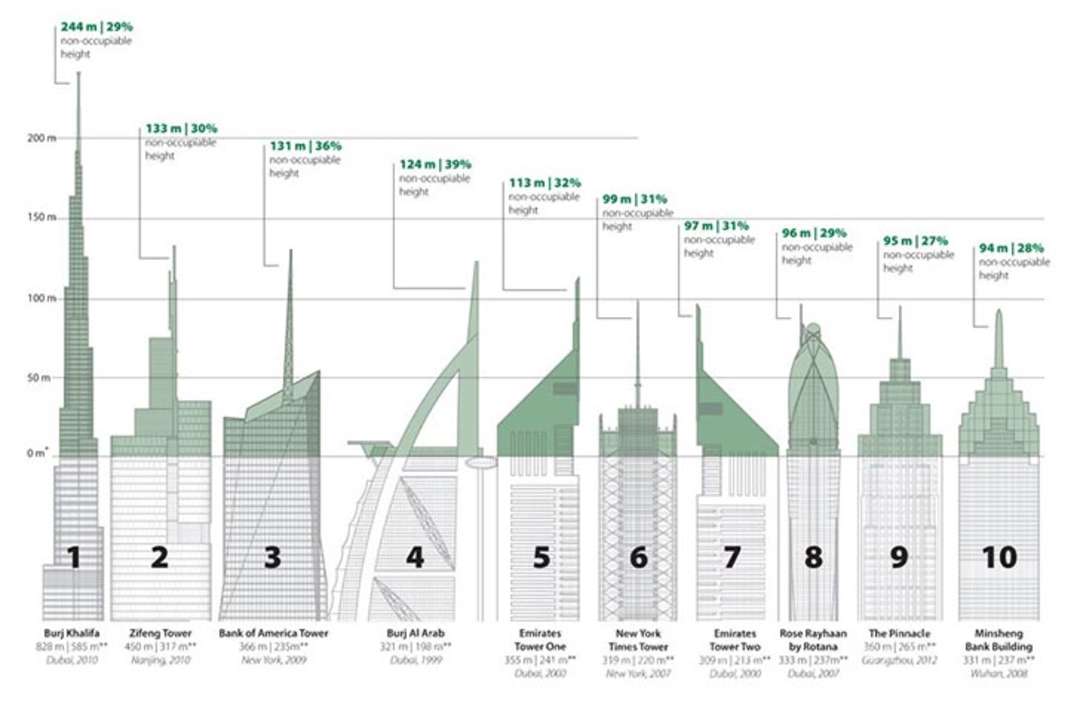It is known among tall-building architects that there are many tricks to increase the height of skyscrapers. But inflated skyscraper height came to the attention of the Council on Tall Buildings and Urban Habitat (CTBUH) last year after a case study suggested that the Kingdom Tower was designed with large decorative "vanity space" on top, inside of its spire, to enhance its height. Kingdom Tower, designed by Adrian Smith + Gordon Gill, is set to be the tallest tower in the world when built.
As a result, CTBUH performed a study which illustrates that large portions of some skyscrapers are actually useless space used to artificially enhance their height, Architizer reports. CTBUH created an infographic showcasing the vanity space phenomenon. Vanity space is defined as the distance between a skyscraper's highest occupiable floor and its architectural top.
Burj Khalifa, currently the tallest building on the globe, at 2,716 feet, has an 800-foot-tall unoccupied spire that accounts for nearly a third of its overall height. Ukraina Hotel in Moscow gets the award for having the largest percentage of vanity space: 42% of its 675 feet is unoccupied space.
See the infographic below, and you can read the full report here.
Courtesy of CBTUH
Related Stories
| Feb 23, 2011
The library is dead, long live the library
The Society for College and University Planning asked its members to voice their thoughts on the possible death of academic libraries. And many did. The good news? It's not all bad news. A summary of their members' comments appears on the SCUP blog.
| Feb 23, 2011
Data center trends: green design, technology upgrades
While green data centers will continue to be a trend within the industry, technology is also driving infrastructure upgrades that have never been seen before, according to the 2011 Data Center Technical Market Report from Environmental Systems Design. The report also includes an overview of the national data center market, construction costs, blackouts and disaster prevention, and site selection.
| Feb 23, 2011
“School of Tomorrow” student design competition winners selected
The American Institute of Architecture Students (AIAS) and Kawneer Company, Inc. announced the winners of the “Schools of Tomorrow” student design competition. The Kawneer-sponsored competition, now in its fifth year, challenged students to learn about building materials, specifically architectural aluminum building products and systems in the design of a modern and creative school for students ranging from kindergarten to sixth grade. Ball State University’s Susan Butts was awarded first place and $2,500 for “Propel Elementary School.”
| Feb 23, 2011
Barbie's newest career: Architect
Mattel is introducing Architect Barbie this fall, following a campaign that started in 2002 to give the iconic blond a design job. The doll comes in a signature pink outfit, but if she's truly hoping to pass an an architect, shouldn't she be wearing all black?
| Feb 23, 2011
Green building on the chopping block in House spending measure
Bryan Howard, Legislative Director of the U.S. Green Building Council, blogs about proposed GOP budget cuts that could impact green building in the commercial sector.
| Feb 23, 2011
Architecture Billings hold steady after two months of improving conditions
After showing positive momentum during the fourth quarter of 2010, the Architecture Billings Index (ABI) slipped almost four points in January. The January ABI score was 50.0, which is down from a reading of 53.9 the previous month, but still reflects stable demand for design services. Any score above 50 indicates an increase in billings.
| Feb 22, 2011
LEED Volume Program celebrates its 500th certified Pilot Project
More than 500 building projects have certified through the LEED Volume Program since the pilot launched in 2006, according to the U.S. Green Building Council. The LEED Volume Program streamlines the certification process for high-volume property owners and managers, from commercial real estate firms, national retailers and hospitality providers, to local, state and federal governments.
| Feb 22, 2011
HDR Architecture names four healthcare directors
Four senior professionals in HDR Architecture’s healthcare program have been named Healthcare directors.












